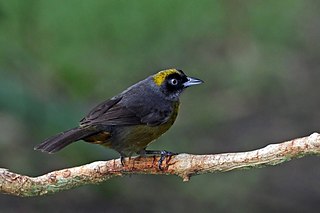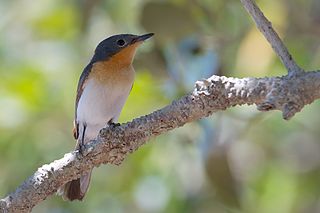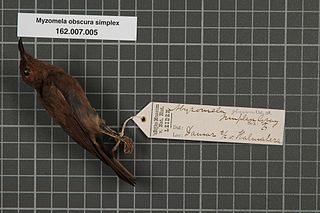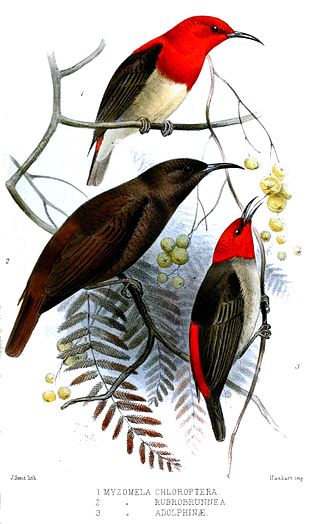
The American black duck is a large dabbling duck in the family Anatidae. It was described by William Brewster in 1902. It is the heaviest species in the genus Anas, weighing 720–1,640 g (1.59–3.62 lb) on average and measuring 54–59 cm (21–23 in) in length with an 88–95 cm (35–37 in) wingspan. It somewhat resembles the female and eclipse male mallard in coloration, but has a darker plumage. The male and female are generally similar in appearance, but the male's bill is yellow while the female's is dull green with dark marks on the upper mandible. It is native to eastern North America. During the breeding season, it is usually found in coastal and freshwater wetlands from Saskatchewan to the Atlantic in Canada and the Great Lakes and the Adirondacks in the United States. It is a partially migratory species, mostly wintering in the east-central United States, especially in coastal areas.

The scarlet myzomela or scarlet honeyeater is a small passerine bird of the honeyeater family Meliphagidae native to Australia. It was first described by English ornithologist John Latham in 1801. At 9 to 11 cm long, it is the smallest honeyeater in Australia. It has a short tail and relatively long down-curved bill. It is sexually dimorphic; the male is a striking bright red with black wings, while the female is entirely brown. The species is more vocal than most honeyeaters, and a variety of calls have been recorded, including a bell-like tinkling.

The purple-throated woodstar is a species of hummingbird in tribe Mellisugini of subfamily Trochilinae, the "bee hummingbirds". It is found in Colombia, Ecuador, and Panama.

The red-faced guan is a species of bird in the family Cracidae, the chachalacas, guans, and curassows. It is found in Argentina and Bolivia.

The dusky-legged guan is a species of bird in the family Cracidae, the chachalacas, guans, and curassows. It is found in Uruguay, northeastern Argentina and southernmost areas of Paraguay and Brazil. In early 2021, the former subspecies P. o. bridgesi, found in southwestern Bolivia and northwestern Argentina, was elevated to species rank as Yungas guan.

The dark-winged trumpeter is a species of bird in the family Psophiidae. It is endemic to Brazil.

The black honeyeater is a species of bird in the honeyeater family Meliphagidae. The black honeyeater exhibits sexual dimorphism, with the male being black and white while the female is a speckled grey-brown; immature birds look like the female. The species is endemic to Australia, and ranges widely across the arid areas of the continent, through open woodland and shrubland, particularly in areas where the emu bush and related species occur.

The dusky-faced tanager is a species of bird in the family Mitrospingidae. It is found in Colombia, Costa Rica, Ecuador, and Panama.

The broad-billed flycatcher is a species of bird in the family Monarchidae. It is found in northern Australia, the Lesser Sunda Islands and southern New Guinea. Its natural habitats are subtropical or tropical moist lowland forest, subtropical or tropical mangrove forest, and subtropical or tropical moist montane forest.

Myzomela is a genus of bird in the honeyeater family Meliphagidae. It is the largest genus of honeyeaters, with 40 species, and the most geographically widespread. It ranges from Indonesia to Australia and into the islands of the Pacific Ocean as far as Micronesia and Samoa.

The cardinal myzomela is a species of bird in the honeyeater family Meliphagidae. It is named for the scarlet color of the male. It is found in American Samoa, New Caledonia, Samoa, Solomon Islands, and Vanuatu, as well as some islands in Micronesia such as Yap. Its natural habitats are subtropical or tropical moist lowland forest and subtropical or tropical mangrove forest. It frequents areas with flowers, such as gardens. This is a small, active bird, measuring about 13 cm (5.1 in) from bill to tail. Males are red and black in coloration, females are grayish-olive, sometimes with a red cap or red head. Its long, curved bill is especially adapted for reaching into flowers for nectar. Cardinal myzomela populations have vanished from the island of Guam since the invasion of the brown tree snake.

The red myzomela is a species of bird in the family Meliphagidae. It is found in New Guinea and New Britain. Its natural habitats are subtropical or tropical moist lowland forests and subtropical or tropical moist montane forests.

The red-headed myzomela or red-headed honeyeater is a passerine bird of the honeyeater family Meliphagidae found in Australia, Indonesia, and Papua New Guinea. It was described by John Gould in 1840. Two subspecies are recognised, with the nominate race M. e. erythrocephala distributed around the tropical coastline of Australia, and M. e. infuscata in New Guinea. Though widely distributed, the species is not abundant within this range. While the IUCN lists the Australian population of M. e. infuscata as being near threatened, as a whole the widespread range means that its conservation is of least concern.

The red-collared myzomela is a species of bird in the family Meliphagidae. It is found in New Guinea. The long-billed myzomela of Goodenough Island was formerly considered conspecific, but was split as a distinct species by the IOC in 2021.

The dusky tapaculo is a species of bird in the family Rhinocryptidae. It is endemic to Chile.

The Yungas guan is a species of bird in the family Cracidae, the chachalacas, guans, and curassows. It is found in the Andean foothills of Argentina and Bolivia.

The Moluccan myzomela is a species of bird in the family Meliphagidae. It is endemic to Indonesia, where it is found on the Maluku Islands. Its natural habitat is subtropical or tropical moist lowland forests.
The red-tinged myzomela is a species of bird in the family Meliphagidae. It was formerly considered a subspecies of the dusky myzomela, but was split as a distinct species by the IOC in 2021. It is found in the Obi Islands. Its natural habitat is subtropical or tropical moist lowland forests.

The Biak myzomela is a species of bird in the family Meliphagidae. It was formerly considered a subspecies of the dusky myzomela, but was split as a distinct species by the IOC in 2021. It is found in Biak. Its natural habitat is subtropical or tropical moist lowland forests.

The reddish myzomela is a species of bird in the family Meliphagidae. It is endemic to Papua New Guinea, where it is found on New Ireland and adjacent islands. Its natural habitats are subtropical or tropical moist lowland forests and subtropical or tropical moist montane forests.



















